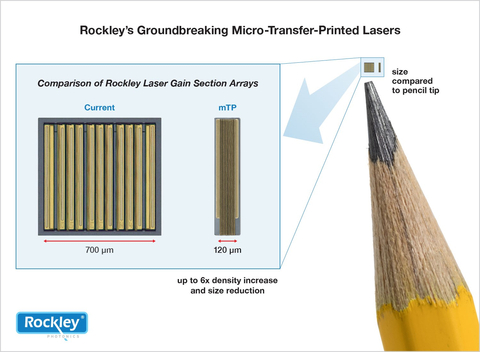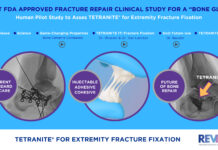OXFORD, England & PASADENA, Calif.– Rockley Photonics Holdings Limited (NYSE: RKLY) (“Rockley”), a global leader in photonics-based health monitoring and communications solutions, today announced that it has developed what it believes to be the world’s first micro-transfer-printed (mTP) silicon-photonics-based laser for commercial applications. This groundbreaking achievement is expected to allow Rockley to further increase the density and reduce the size of its high-density spectrophotometer chips — which are already the world’s smallest for broadband infrared wavelength laser spectrometry (covering 1000 nanometers of spectrum) and are smaller in area than LED-based solutions currently used in wearables.
This advancement could potentially have a significant impact across a wide range of applications, including the design of exceptionally small wearable devices for the detection and measurement of multiple biomarkers. New silicon-photonics-based biosensing chips using mTP technology are expected to be available in the first half of 2024. The new chip technology should have no impact on the upcoming launch of Rockley’s Bioptx™ biosensing band nor on any current-generation products that Rockley and its customers are developing.
With this breakthrough in the mTP of silicon-photonics-based lasers, Rockley has dramatically increased the laser density of its photonics integrated circuits (PICs) for biosensing, creating what it believes to be the world’s highest-density broad-wavelength laser spectrophotometer chip, surpassing its own previous achievements. Moreover, the mTP process is expected to reduce manufacturing costs and enable thinner, smaller footprint and higher-density chip designs. These attributes are powerful benefits for use in consumer and medtech devices and could facilitate the integration of Rockley’s biosensing technology into future tiny wearables.
Leveraging the mTP process, the new PIC technology will integrate a laser-generating “membrane” with a thickness of only 4 microns. The potential applications for this higher-density and smaller-footprint chip technology extend beyond biosensing and health monitoring into other areas, such as ultra-small wearables, clothing, or XR/VR/AR headsets and glasses.
This mTP breakthrough is the direct result of Rockley’s multi-year partnership with the Tyndall National Institute at University College Cork in Ireland, X-Celeprint Limited, and the Irish Photonics Integration Centre (IPIC), with funding support from the Irish government’s Science Foundation Ireland (SFI) and Disruptive Technologies Innovation Fund (DTIF). The project started five years ago with a focus on developing a custom mTP process for Rockley’s silicon photonics platform and has involved a multidisciplinary team of world-class engineers and researchers. This technology, along with many other Rockley innovations, is backed by a robust multidisciplinary patent portfolio of over 200 issued patents and 295 pending patents in total.
“Applying the micro-transfer printing process to the production of integrated lasers is a huge breakthrough that we believe will have a tremendous impact on wearable biosensing and on the photonics industry as a whole,” said Dr. Andrew Rickman, chairman and chief executive officer of Rockley. “We arguably have some of the most sophisticated photonics technology in the world, and this unprecedented level of miniaturization raises the bar even further. By creating biosensing chips that are smaller, lower-cost, and more efficient, we can continually improve our wearable biosensing products and deliver novel, relevant, and more powerful ways to monitor our health.”
“I believe that this next-gen, heterogeneous integration platform will lead to several significant technological advancements, including higher densities of lasers, increasingly smaller chip sizes, and ultra-high-volume manufacturing,” said Aaron Zilkie, chief technology officer of photonics at Rockley. “The team has been working on this project for years, and we are extremely excited to have reached this important milestone. We are grateful for the close collaboration we’ve had with our research partners and for the funding support from the Irish government and its Science Foundation Ireland and Disruptive Technologies Innovation Fund.”






